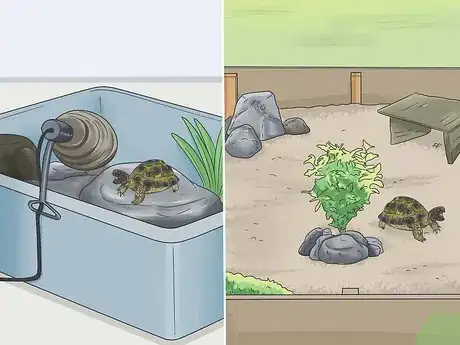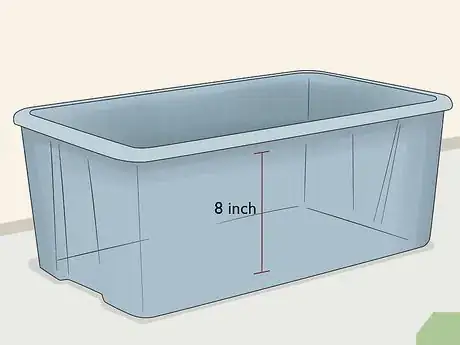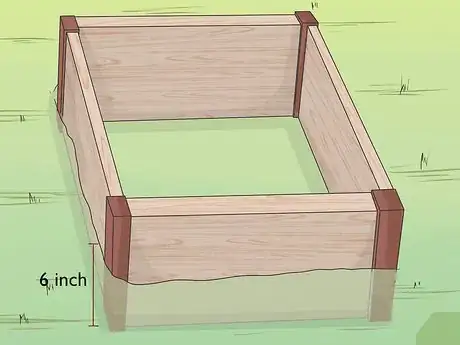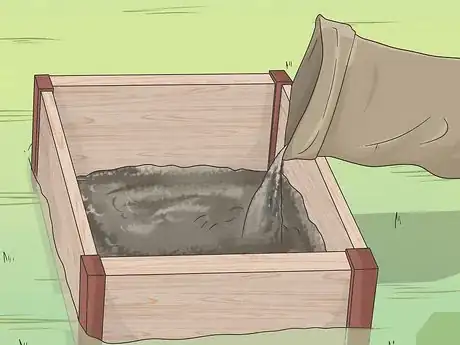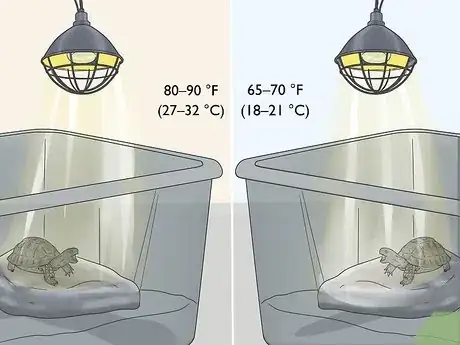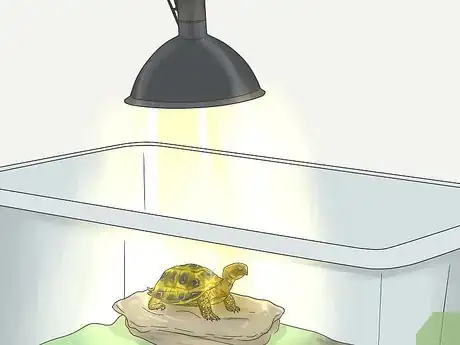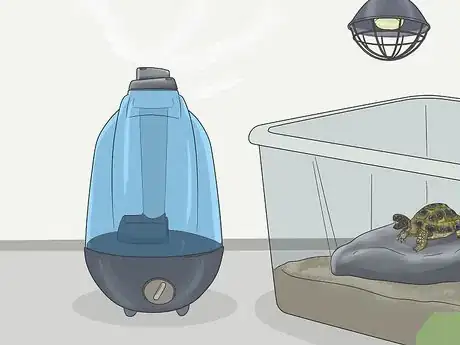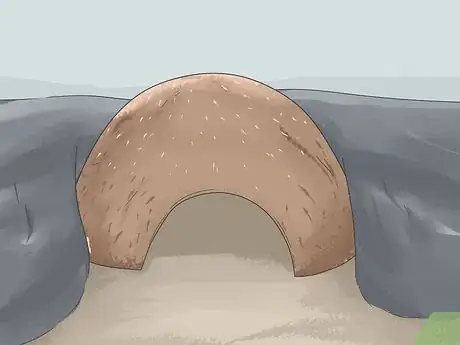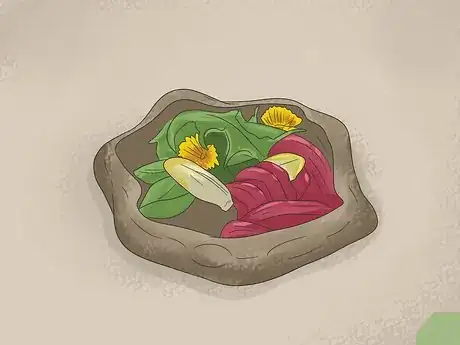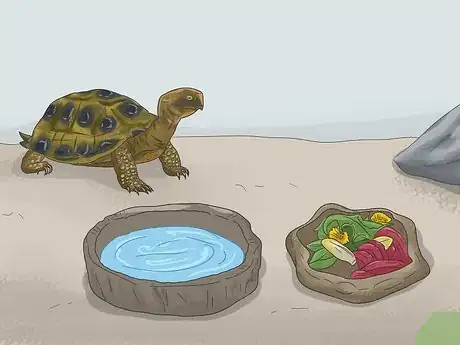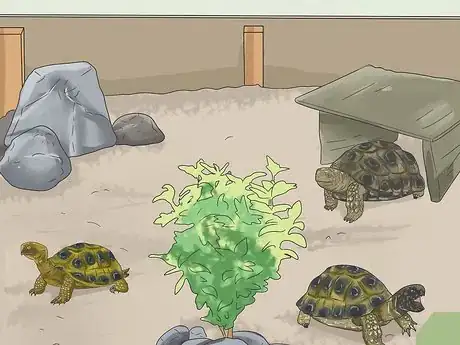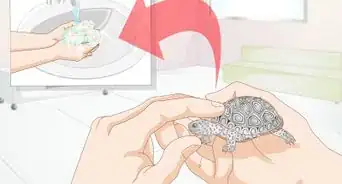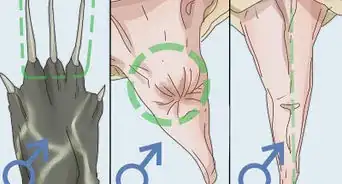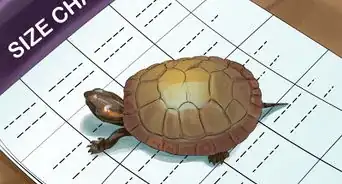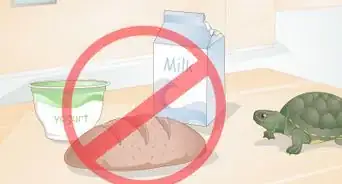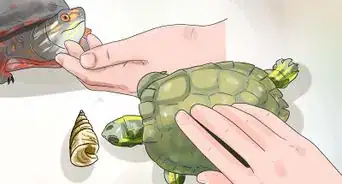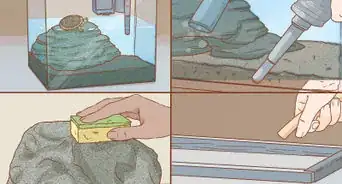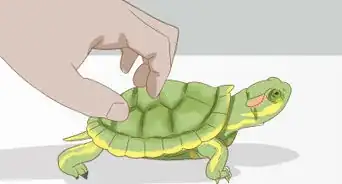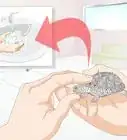This article was co-authored by Jaime Nalezny, DVM. Dr. Jaime Nalezny is an exotic animal veterinarian with over 15 years of experience, focusing on the care of birds, reptiles, amphibians, and exotic small mammals. Dr. Nalezny founded The Iguana Relocation Network and is on the board of directors for Midwest Avian Adoption & Rescue Services. She graduated from the University of Minnesota College of Veterinary Medicine in 2005.
There are 8 references cited in this article, which can be found at the bottom of the page.
wikiHow marks an article as reader-approved once it receives enough positive feedback. This article received 15 testimonials and 88% of readers who voted found it helpful, earning it our reader-approved status.
This article has been viewed 186,541 times.
Hermann's tortoises are naturally suited to hot, humid environs. If you are going to keep tortoises healthy in captivity, you must mimic their natural ecosystem. Make sure that they have plenty of light, heat, and space to dig. Happy, healthy Hermann’s tortoises can live for as long as 75 years.
Steps
Building the Enclosure
-
1Decide whether you want an indoor or outdoor habitat. Hermann’s tortoises can be kept either indoors or outdoors, as long as the weather permits. Tortoises need to regularly bask in the heat of the sun or a lamp. Consider the positive and negative consequences of each option: it might be easier to find space for your tortoises outside the house, but an indoor environment may be easier to maintain. This particular kind of tortoise has a specific temperature range, so it may not be feasible to keep a tortoise outside if you live in a cold region.
-
2Create an indoor habitat. To start, build a box out of plywood or a plastic container. Build the enclosure at least 4 by 3 feet (1.22 m × 0.91 m) or 8 times longer than your tortoise; adults are usually 6–8 inches (15–20 cm) long. If possible, your enclosure should be even larger on all sides.
- If you build the enclosure out of wood, be careful not to use cedar or pine. The acids in the wood can harm your tortoises.
- You can seal wood with polyurethane or put a linoleum liner at the bottom of the enclosure to help make cleaning easier.
- Make sure to build a floor into the enclosure. Coat the floor with sand and soil to give the tortoises a place to dig. If you use an indoor habitat, it should mimic the outdoors as much as possible.
Advertisement -
3Try building a "tortoise table". There are different kinds of indoor pens, but a “tortoise table” is a simple and cost-effective solution. Start with a bookcase (or a wardrobe with the doors removed) laid on its back. Sink a tray for water into the wood. The tray should be large enough for the tortoise to stand in, but not deep enough to submerge its head. Lay a substrate of mixed compost and sand to a depth of about 4 inches (10 cm).
-
4Build an outdoor enclosure. Choose a warm, dry area that gets a lot of sun. As always, the more roaming space the better. Make sure the sides of the pen are buried at least 6 inches (15 cm) deep so predators can’t dig underneath it. Other animals may hurt your tortoises if they wander too far and get lost.
- It's much easier to house a tortoise outside if where you live gets to around 65–80 °F (18–27 °C), but if you don't live in a tropical or subtropical region, you must build an indoor enclosure.
- Hermann’s tortoises love to dig, so be sure to put your fence deep into the ground. Try building your enclosure atop something solid that the tortoises cannot dig through. This might be concrete, brick, or wood. For a cheap and effective barrier, try laying down chicken wire beneath a few inches of soil.
- Consider which direction your garden faces – the direction from which it gets most of its sun. If you have a north-facing garden, prepare the tortoise for hibernation by late September. Otherwise, your tortoises may stay out until late October, if it stays warm and dry enough.
- If you can’t build an enclosure outside, then take your tortoise outdoors a few days per week during the warmer months so they can forage and get UVB rays from the sun.
-
5Fill the enclosure with a substrate. Make sure to use a filling with a fine grain, such as soil or sand. You can also mix different types of substrates to create suitable bedding, such as topsoil with play sand. Mist the substrate with a spray bottle so it doesn’t dry out entirely and the enclosure has a humidity of about 70%.[1]
- It’s a common misconception that tortoises need to stay dry at all times. While it’s more important for tortoises to have a dry substrate while hibernating, they still need proper hydration weekly.
- Newspaper, pellets, and sand couldn't hold enough moisture, they're not appropriate burrowing material either.
- Avoid clay-type soil, as this type of earth tends to hold much more moisture than regular soil.
Regulating Heat and Light
-
1Keep the habitat warm. Keep the enclosure at 80–90 °F (27–32 °C) during daytime and 65–70 °F (18–21 °C) at night.[2] If you are keeping your tortoises indoors, you must also provide plenty of light and a place to bask.
- Consider keeping a small thermostat in the enclosure so that you can monitor the temperature and keep it steady. This is most important at first, as you establish the tortoises in their new environment.
- The tortoise should be okay if it is cool at night, as long as it is also dry. Make sure that your tortoise can raise its temperature during the day.
-
2Set up a basking spot by using a heat lamp and a UV lamp. Tortoises bask in the sunlight in order to digest and absorb nutrients from their food. You don't need to build anything special – just ensure that one part of the enclosure will always be warm enough to meet the needs of a post-meal tortoise.[3]
- Look for ceramic heating bulbs that do not emit light. You can leave these bulbs on at night as well.
- If you build your enclosure outdoors in a hot region, then you don't need to worry about making an artificial basking spot. Your tortoises will bask in the heat of the sun.
-
3Light up the enclosure during the day. If you are keeping your tortoises indoors and out of direct sunlight, keep the space lit with linear UVB bulbs spanning across the top of the enclosure so there’s UVB penetration throughout it. Set the light up in a central location or use a linear bulb that’s the same length as the enclosure to illuminate the entire space. Check the UVB reading with a lamp meter to make sure its the same throughout the enclosure. Leave the light on for 8-12 hours a day.
- Check the UVB output and decay of the bulbs with a UV meter regularly to ensure they’re working properly.
- Tortoises like it hot, but they won't be able to safely handle temperatures much higher than 80 °F (27 °C). If the habitat gets too hot, move the bulb. Hang it higher above the enclosure.[4]
- You can buy a combination light, such as a mercury vapor bulb, that you can use for your tortoise’s heat and UVB requirements.
-
4Keep the humidity around 50 – 65%. Consider using a humidifier to regulate moisture levels. Place the humidifier directly into the enclosure, or just humidify the entire room. This is especially important if you live in a cold climate and use heating in the house – central heating tends to dry up the air.[5]
Filling and Maintaining the Enclosure
-
1Build hiding places. Hermann’s tortoises like to dig and hide, so it is important to provide a place where they can feel safe. Try building a small "tortoise house", or simply giving the tortoises a plastic food container with a hole to enter and exit. Tortoises tend to sleep in their "hiding area".
- This is especially important if you are keeping your tortoises in a very hot place. Make sure that your animals have a shady place to retreat if they get too hot.
- If you have an outdoor enclosure, make sure that it is safe from predators – including birds. Tortoises are hardy creatures, but they cannot defend themselves against all animals.
-
2Provide ample food and water. Hermann’s tortoises do not eat meat or grains. They eat a variety of vegetables, such as endive, radicchio, dandelion, as well as weeds and flowers, like hibiscus, dandelion, clover, roses, and carnations. Make sure any plants you give them are free of herbicides and pesticides, or else you could harm the tortoise. You may also provide a formulated tortoise feed for a portion of their diet as well. Give them fresh food every day and every other day when they're older, wash it carefully with water before serving. Replenish a supply of clean water in a shallow bowl or container daily.
- Tortoises also need calcium in their diet. Let them nibble small pieces of grit from your garden. They are also fond of clover.[6]
- If Hermann leaves something, it means they do not like it. It usually easy to tell a tortoise's preferences by watching its behavior.
- Hermann's tortoises kept outdoors will often make a point of coming out during a rainstorm and drinking from puddles.
- Never feed a tortoise with cat or dog food. Dog and cat food usually contain meat, grains, and other bits that tortoises can't easily digest or over-consume.
-
3Keep the space clean. Replenish the water and food trays daily. Change the substrate once a month, or whenever it seems especially filthy - If you can't afford to completely refill the substrate, try churning the soil and/or plant live greenery that absorbs Ammonia and Nitrates.
-
4Be cautious about keeping multiple tortoises in the same enclosure. Be aware that putting many tortoises together can cause problems, that includes enclosure space issues. Two males, put together, will tend to fight over territorial disputes.[7] However, tension may also arise if the female to male ratio is too small: the male often won't leave the female alone, and she can become too stressed. If you notice that the tortoises are bothering one another, you need to move them into separate enclosures.
-
5Be gentle and give them space. Hermann's tortoises do not usually enjoy behind handled.[8] Make sure to treat your animals gently when moving them into their new enclosure. Hold a tortoise with two clean hands, and do not drop it. Avoid handling the tortoises for at least a few days after you bring them home. They can be slow to adjust, and they need time to settle into their new enclosure.
Expert Q&A
Did you know you can get expert answers for this article?
Unlock expert answers by supporting wikiHow
-
QuestionCan you use hay in the enclosure instead of ready grass?
 Jaime Nalezny, DVMDr. Jaime Nalezny is an exotic animal veterinarian with over 15 years of experience, focusing on the care of birds, reptiles, amphibians, and exotic small mammals. Dr. Nalezny founded The Iguana Relocation Network and is on the board of directors for Midwest Avian Adoption & Rescue Services. She graduated from the University of Minnesota College of Veterinary Medicine in 2005.
Jaime Nalezny, DVMDr. Jaime Nalezny is an exotic animal veterinarian with over 15 years of experience, focusing on the care of birds, reptiles, amphibians, and exotic small mammals. Dr. Nalezny founded The Iguana Relocation Network and is on the board of directors for Midwest Avian Adoption & Rescue Services. She graduated from the University of Minnesota College of Veterinary Medicine in 2005.
Exotic Animal Veterinarian
-
QuestionIf I leave my baby tortoise outdoors she gets sunlight, but will the temperature be good in winter? The lowest temperature in my area is 6 degrees at night but plenty of sun during the day. Should i worry?
 Jaime Nalezny, DVMDr. Jaime Nalezny is an exotic animal veterinarian with over 15 years of experience, focusing on the care of birds, reptiles, amphibians, and exotic small mammals. Dr. Nalezny founded The Iguana Relocation Network and is on the board of directors for Midwest Avian Adoption & Rescue Services. She graduated from the University of Minnesota College of Veterinary Medicine in 2005.
Jaime Nalezny, DVMDr. Jaime Nalezny is an exotic animal veterinarian with over 15 years of experience, focusing on the care of birds, reptiles, amphibians, and exotic small mammals. Dr. Nalezny founded The Iguana Relocation Network and is on the board of directors for Midwest Avian Adoption & Rescue Services. She graduated from the University of Minnesota College of Veterinary Medicine in 2005.
Exotic Animal Veterinarian If you mean 6°C, this is not an ideal situation for a young, growing tortoise overnight, but you can bring it indoors overnight and keep it outside during the day if basking temperatures can reach 90°F (27-32°C). If they don’t get this warm, just bringing her outside for short periods (30-60 minutes) of time daily when the weather is near 27°C/80°F while you are around to protect her is fine.
If you mean 6°C, this is not an ideal situation for a young, growing tortoise overnight, but you can bring it indoors overnight and keep it outside during the day if basking temperatures can reach 90°F (27-32°C). If they don’t get this warm, just bringing her outside for short periods (30-60 minutes) of time daily when the weather is near 27°C/80°F while you are around to protect her is fine.
Warnings
- When providing a hiding area, make sure that the tortoises cannot fall down or flip over from climbing over it. Domed or arched hiding spots reduce these incidents from occurring.⧼thumbs_response⧽
- If a tortoise stays on its back (carapace), their stomach eventually presses on to their lungs which causes difficulty breathing, and if they're exposed to a heat source, they can overheat as they couldn't retreat into cooler areas.⧼thumbs_response⧽
- If you keep your pet tortoises outdoors, make sure there is shade available to prevent them from overheating.⧼thumbs_response⧽
- When providing a water dish, make sure that it is shallow and that the water does not reach above their carapace. Hermann’s tortoises can drown in water.⧼thumbs_response⧽
- Make sure you also cover the top of your outdoor pen with a hinged top so you can still easily get inside. It can be covered with wire or mesh that predators can’t chew through. This will prevent birds, dogs, cats, and wildlife (raccoons, opossums, and skunks) from climbing over and eating your tortoises.⧼thumbs_response⧽
- Make sure you leave some area that is not covered with grass to allow the tortoise to dry off or dampen itself. If you do plant grass or any other plants in the tortoise enclosure, make sure that you aren't using any pesticides or chemical fertilizers. The tortoises love to eat the grass.⧼thumbs_response⧽
References
- ↑ http://www.tortoisetrust.org/articles/substrates.html
- ↑ http://www.austinsturtlepage.com/Care/cs-easthermanns.htm
- ↑ http://www.hermann-tortoise.co.uk/
- ↑ http://www.reptilecentre.com/info-hermanns-tortoise-care-sheet
- ↑ https://www.tescoliving.com/health-and-wellbeing/your-health/2014/october/how-to-protect-your-health-from-central-heating
- ↑ http://www.petsworld.co.uk/tortoises.htm
- ↑ http://www.tortoise.org/archives/herman.html
- ↑ http://www.petscorner.co.uk/petopedia/all-about-hermanns-tortoises/
